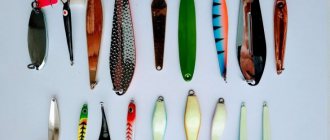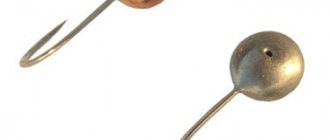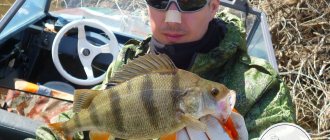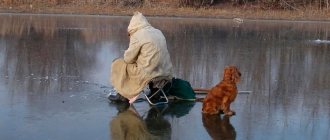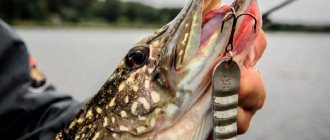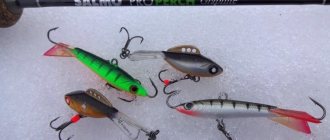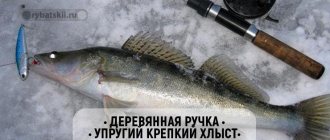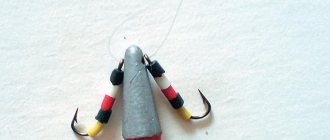Flashing is the most effective way of hunting river predators in the winter. You can happily catch pike, perch, pike perch and even trout. And at the same time, you don’t have to spend money on expensive fishing gear; you can make a fishing rod for trolling, for example, with your own hands.
Since the conditions in which winter gear is used are much more severe, there are more requirements for them. To create a truly effective winter fishing item, decide on the type of winter lure for catching predators. This is the only way you can make truly high-quality and effective gear.
Materials and tools for a homemade winter fishing rod for trolling
When selecting fishing gear for winter trolling, it is necessary to take into account some nuances. This technique of catching a predator involves continuous movement across a body of water. This means that the gear must be convenient, efficient and light.
List of required tools:
- hacksaw;
- sandpaper;
- superglue or epoxy resin;
- stationery knife;
- needle file;
- drill;
- Bulgarian.
It is worth noting that the list may vary depending on the selected type of fishing rod that you want to create with your own hands.
What to use as a whip
Your entire fishing will depend on the quality of the whip, its length and stiffness, which is why this issue should be given special attention. Inexpensive fishing rods include whips made from polypropylene, cardboard or polystyrene. The first two options quickly deform, while the last one simply bursts right there while fishing.
Most fishermen prefer fiberglass-based whips. If you plan to hit hard, pay attention to carbon fiber whips.
It is very important in this case to determine the rigidity of the equipment, which is achieved by changing the length of the whip and the thickness of the material used.
If you have the technical ability, you can create whips from light titanium alloys. This option is perfect in combination with heavy baits at impressive depths or in strong currents.
What is the handle made of?
The shape of the lure handle may differ little from each other. The difference in this case lies in the material of manufacture. It could be polystyrene foam, polystyrene foam or even cork.
The main thing is that the material has the necessary heat transfer and lightness. After all, you will have to hold such a handle with your bare hands in the cold.t goes here
What bait to use for perch in winter
With the onset of sub-zero temperatures, perches hide at depth in holes. They do not swim to the shallows or shore. Winter fishing is wonderful, but requires thorough preparation - it is important to choose fishing rods with a jig.
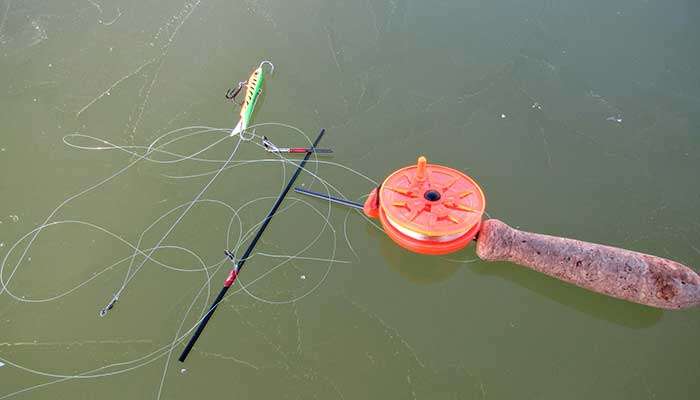
As soon as the first ice appears, you need to go fishing - an active bite awaits the amateur. Lasts for 3-4 weeks. Zhor resembles pre-spawning. It is better to use a jig as bait.
Perch also loves animal bait.
Can choose:
- pieces of fish;
- bloodworm;
- red worm;
- perch eye with intact iris;
- dragonfly larvae.
Experienced fishermen have noticed that fish respond better to moving bait. You need to pull the bait towards you with smooth movements.
At the end of December, the bite decreases, the schools break up and swim to the bottom.
Methods for making a winter fishing rod for trolling

There are many ways to create fishing rods for winter trolling. It is important to find the option that will allow you to make gear that is effective and convenient for you individually.
Fishing rod with wooden handle

A wooden handle can be created from any wood. To do this you will need a hacksaw, sandpaper and a knife. Using a drill, we make a 250 mm hole at the end of the workpiece. Moreover, the diameter of the drill must correspond to the thickness of the whip itself.
You can remove the unnecessary end of the fishing rod using a grinder, but other available means will also work. It all depends on your preferences and the available tool. In order for the wooden handle to remain practical and aesthetically pleasing longer, it can be additionally treated with an antiseptic or painted.
A coil is attached to the previously created handle using insulating tape. And after connecting the whip to the handle, the fishing rod is ready.
Foam fishing rod
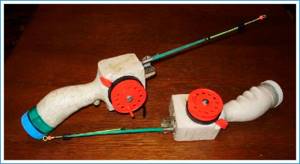
It’s quite easy to create a fishing rod based on foam plastic with your own hands. The difficulty lies in finding really high-quality dense material. Such a foam handle will have excellent heat dissipation, which will allow you to use it with bare hands even in severe frosts.
Step-by-step instructions for creating a fishing rod from foam:
1. Prepare a piece of dense hard foam in advance. Its dimensions should correspond to the size of your hand, so that in the future it will be comfortable to hold the fishing rod.
2. In the middle of the workpiece, or rather along it, make a small notch for subsequent placement of fishing line into it. It is better if it is wider, so the thread will be more convenient to wind.
3. Make a hole on one side of the side for the fishing rod and fasten it securely.
4. You must first prepare this fishing rod.
4.1 Find the end of the telescopic fishing rod and make a hole in the foam piece for it. Moreover, the fishing rod must be tightly inserted into the groove to prevent its further falling out during operation.
4.2 Before final fixing the fishing rod, super or epoxy glue is poured into the hole. It is recommended to ensure reliable fastening of the latter in the groove.
5. At the end of the fishing rod, carefully fix the nod. You can purchase it in a specialty store or make it yourself from a nipple, a spring, including wire with good elasticity parameters.
6. And finally, you will need to wind the monofilament onto the fishing rod, insert the rig through the nod and you're done! You can safely go fishing.
Fishing rod for winter trolling without a reel
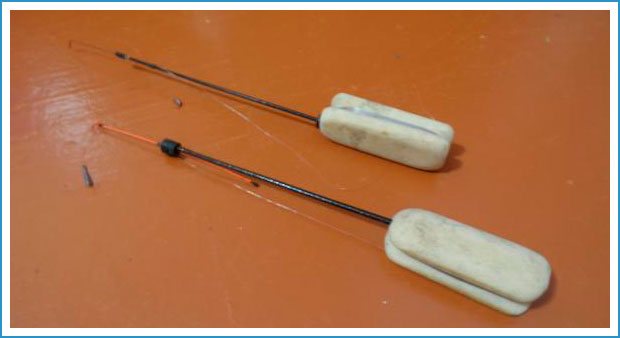
The trolling rig without a reel is the same foam rig that we looked at earlier. Although you can come up with many other options. For example, a fishing rod made from a champagne cork. To do this, you will need to prepare 5-7 such plugs in advance.
Stages of creating a fishing rod from corks
- Drill a through hole in the center of each plug.
- Carefully process the edges of each workpiece to ensure their best adhesion to each other.
- Place the plugs on the whip, first securing them with superglue at the end.
- After the equipment has completely dried, distribute the three guide rings evenly over the whip. It is very important to maintain one line of location of these rings.
Here you can also buy a reel and wrap it with electrical tape, or you can, as in the version with a wooden handle, make a recess for winding the fishing line around the handle itself. It all depends on your imagination.
Fishing rod for winter trolling with reel

A trolling rod with a reel, like a foam fishing rod, is perfect for winter fishing. Plus, it is particularly efficient and easy to use. But you will have to work hard to create it, including using your creative talents.
Stages of creating tackle for winter trolling with a reel:
Before you start creating a fishing rod, go to a fishing store and purchase a reel and a whip. Moreover, prepare a piece of rigid foam slightly larger than the coil itself.
1. Take the foam and cut it slightly wider, 3-4 mm, than the coil itself.
2. We drill a through hole in the foam plastic that is 20 mm smaller than the diameter of the coil.
3. We create another hole, but not a through one, so that a layer of foam plastic 4 mm high remains at the bottom.
4. Place the coil in a foam piece and process it carefully to give it a marketable appearance.
5. Please note that the coil also requires additional upgrades.
6 Remove the coil leg, we won't need it.
6.1 We also remove the edge of the coil that bends; it’s worth saving only three legs. They should be positioned evenly around the circumference to further secure the coil to the workpiece.
7. Moreover, at the moment of combining the workpiece and the spool, it is necessary to provide the lever with free access for normal switching when winding up the monofilament thread.
8. For aesthetics, the workpiece is refined using a file and sandpaper.
9. Having heated the needle well, create a hole for the monofilament in the workpiece so that it is flush with the line coming off the reel. This will eliminate friction of the thread on the foam body.
10. Using a drill, create a hole for the whip. Moreover, the drilling speed should be minimal to prevent damage to the foam blank. The hole should not be through, although it should be deep enough to securely fix the whip.
11. A passage ring for monofilament thread is attached to the base of the whip.
12. Then you need to do the nodding.
12.1 Buy, for example, a nod for smelt in the store. It will need to be reworked somewhat.
12.2 Having reduced the ball at the end of the nod to a small cone, proceed to shorten the spring.
12.3 We replace the rubber bushing with a foam one.
12.4 And only then do we begin to create two holes: one for the spring, and the other for the whip.
12.5 The bracket is inserted flush into the first hole, and the nod itself is inserted into the second hole. Moreover, it is recommended to glue the bracket tightly with epoxy resin.
13. We wind the monofilament thread through the spool, making sure to thread it through the previously created hole in the foam, through the pass ring and the nod itself.
Adviсe
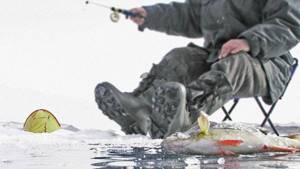
- If you decide to use a balancer, then fishermen also recommend using a small silicone twister. This works quite effectively;
- If you decide to fish in a still body of water, use a slow pace of trolling using light lures;
- whereas in the middle current it is necessary to speed up somewhat and make movements more sharply, using a much heavier spoon. After all, others can be carried away by the current;
Remember, the trolling method in winter is not suitable for powerful currents. The gear will be carried away and lifted to the ice, even the game will be unsuitable for good fishing.
Reviews
- Vasilich noticed that making a fishing rod from cork would not be difficult, so he did not understand the guy who buys such tackle in a store;
- Kochevnik also approved such tackle with very flexible whips, but if they break you will have to work hard. And I don’t like it that much.
- SPORTSMEN actually said that such fishing rods belong at the exhibition.
- Krasnobaisky perch advised creating the shape of the fishing rod handle so that it fits well in the hand.
- The driver actually said that you couldn’t think of a better fishing rod than you could make yourself. It is only important to put your soul into its creation.
In conclusion, I would like to note that winter fishing using the lure method involves hunting a predator. The latter most often gives preference to fry, which are in constant motion throughout the reservoir.
Therefore, you should not chain yourself to one place. Move! After all, movement is life. And in our case, it is also the key to good fishing.
Perch: general information
The striped predator is a prominent representative of the European ichthyofauna, as well as the central and northern regions of Asia and North America. In terms of brightness of color, it is second only to brook trout and grayling, but the population of the latter is much smaller, and finding them in mid-latitudes is problematic.
There are two types of fish in the reservoirs, which practically do not differ in body shape, but have different colors of the body and fins - these are common perch and American yellow perch . And although the river common perch looks almost the same as its American relative, at the genetic level they are different species.
The fish rarely grows to impressive sizes, but in remote regions there are real giants. By the way, the largest perch ever caught weighed about 6 kg, and its body length exceeded 50 cm. In most cases, small humpbacks weighing from 150 to 300 g and the size of a palm are caught on the hook. When fishing with heavy spinning baits, you occasionally come across heavier specimens - more than 1 kg.
When planning to engage in winter trolling, you need to correctly approach the issue of choosing bait. You must remember that winter products for stripers differ from spinners for catching other predators only in their size. As a rule, these are compact, narrow-bodied baits 3-7 cm long, which are made of copper, brass and stainless steel plates , treated with or without galvanic coating.
To increase the weight of the product, lead is soldered onto one of its surfaces. The number of hooks varies from one to three. The bait creates attractive movements in the water column due to its unique shape and bend. In some cases, summer spoons with small sizes and a thin body are used for winter fishing.

